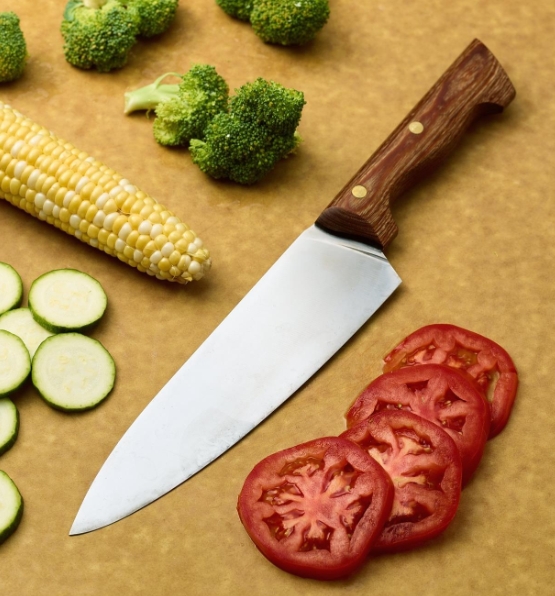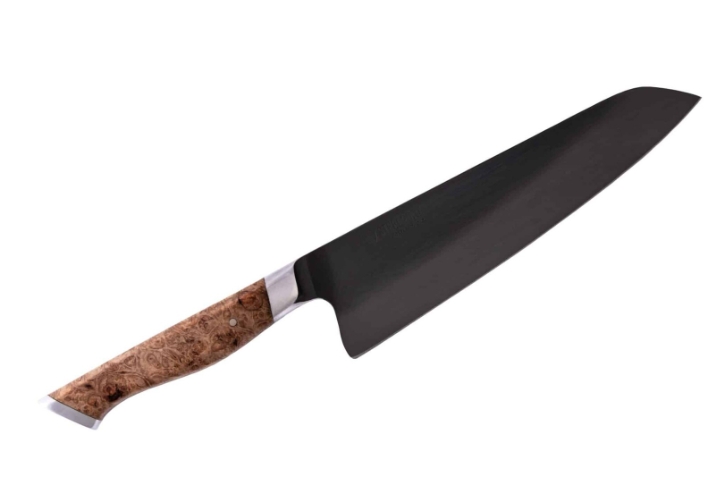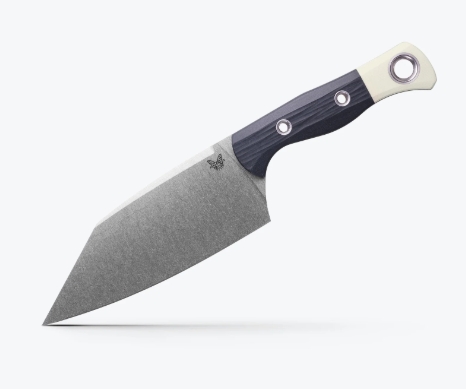

Views: 222 Author: Ella Publish Time: 2025-05-02 Origin: Site








Content Menu
● Understanding the Importance of a Chef Knife
● Key Factors to Consider When Choosing a Chef Knife as a Gift
>> 4. Handle Design and Material
● Popular Types of Chef Knives to Consider
>> Gyuto Knife
>> Nakiri Knife
● Additional Considerations When Choosing a Chef Knife as a Gift
>> Personal Preferences and Style
>> Knife Maintenance and Sharpening
>> Cultural and Symbolic Meanings
● Presentation and Gift Etiquette
● FAQ
>> 1. What blade length is best for a beginner cook?
>> 2. Should I choose stainless steel or carbon steel for a gift knife?
>> 3. How important is the handle material and design?
>> 4. Can I gift a knife to someone who is left-handed?
>> 5. How should I present a chef knife as a gift?
Choosing the perfect chef knife as a gift can be a delightful yet challenging task. A chef knife is an essential tool in any kitchen, cherished by both professional chefs and home cooks alike. Giving a high-quality chef knife not only enhances the recipient's cooking experience but also shows thoughtfulness and appreciation for their culinary passion. This comprehensive guide will walk you through everything you need to know to select the ideal chef knife for your loved one, covering blade types, materials, sizes, ergonomics, and presentation. Additionally, you will find helpful visuals and videos to illustrate key points, along with a detailed FAQ section to answer common questions.

A chef knife is often considered the cornerstone of kitchen tools. It is versatile, capable of handling a wide range of tasks such as chopping, slicing, dicing, and mincing. Most chefs rely on their chef knife for about 80% of their cutting needs, making it an indispensable kitchen companion. Choosing the right chef knife can transform food preparation from a chore into an enjoyable and efficient process.
The right chef knife not only improves cutting precision and speed but also reduces fatigue and the risk of injury. When a knife fits well in the hand and is balanced properly, it feels like an extension of the cook's arm, allowing for fluid, controlled movements. This connection between the cook and their knife is why gifting a chef knife is more than just giving a tool-it's giving an experience.
Chef knives typically range from 6 to 12 inches in blade length. The ideal size depends on the recipient's hand size, cooking style, and the tasks they perform most often:
- 6 to 8 inches: Easier to maneuver, great for home cooks or those with smaller hands, perfect for intricate tasks like peeling or mincing garlic. This size is also excellent for those who prefer more control and precision.
- 8 to 10 inches: The most versatile size, suitable for a wide range of kitchen tasks including chopping large vegetables and carving meat. It balances reach and control, making it the most popular choice among both professionals and home cooks.
- 10 to 12 inches: Favored by professional chefs or those who handle large cuts of meat, providing more knuckle clearance and longer slicing strokes. These longer knives can speed up prep work but require more skill to handle safely.
When choosing the blade length, consider the recipient's kitchen space as well. A smaller kitchen might benefit from a more compact knife that is easier to store and maneuver.
The blade material affects sharpness, durability, maintenance, and overall performance:
- Stainless Steel: Resistant to rust and staining, low maintenance, and ideal for everyday use. A great choice for gift recipients who prefer ease of care. Modern stainless steel knives can hold a sharp edge for a reasonable time and are often dishwasher safe, though hand washing is recommended.
- Carbon Steel: Sharper and easier to sharpen but requires more maintenance to prevent rust and patina formation. Preferred by chefs who enjoy sharpening their knives regularly and want a razor-sharp edge. Carbon steel blades develop a patina over time, which some cooks appreciate as it adds character and natural non-stick properties.
- Laminated Steel (Damascus): Combines a hard core steel for sharpness with softer outer layers for durability and ease of sharpening. Often features attractive layered patterns that make the knife visually unique. Damascus knives are prized for their beauty and performance, making them a luxurious gift option.
The choice of blade material also influences how the knife should be cared for. For example, carbon steel knives should never be left wet and need to be dried immediately after washing to avoid rust.
- Double-Bevel (Western style): Ground on both sides, usually at an angle of 20-30 degrees. Suitable for both left- and right-handed users, durable and versatile. This edge is forgiving and robust, ideal for general kitchen use.
- Single-Bevel (Japanese style): Ground on one side, offering a sharper edge with a smaller angle (12-18 degrees). More precise but requires careful handling and is often preferred by experienced chefs for tasks like slicing sashimi or fine vegetable work.
- Hollow Ground Edge: Features concave grooves on the blade sides to reduce friction and prevent food from sticking. This design is common in Santoku knives and helps improve slicing efficiency.
Understanding the edge type is important because it affects how the knife cuts and how it should be sharpened. Single-bevel knives require specialized sharpening techniques and are often not recommended for beginners.
The handle should provide a comfortable, secure grip and balance the blade well. Common handle materials include:
- Wood: Offers a traditional look and comfortable feel but requires maintenance to avoid damage from moisture. Handles made from stabilized wood resist cracking and warping.
- Composite or Resin: Durable and easy to clean, often designed ergonomically for comfort. These handles are resistant to moisture and bacteria, making them hygienic and low maintenance.
- Metal: Sleek and durable but can be slippery or cold to the touch. Some metal handles feature textured grips to improve safety.
The knife's tang (the metal part extending into the handle) is crucial for balance and strength. Full tang knives, where the metal runs the entire length of the handle, are generally preferred for durability and control. Partial tang knives are lighter but less balanced and often less durable.
Ergonomics play a vital role in handle design. Handles shaped to fit the contours of the hand reduce fatigue and improve control during extended use. Some knives feature bolster designs that protect fingers and improve grip.
A well-balanced knife feels like an extension of the hand. It should neither be too heavy nor too light. The weight distribution between blade and handle affects control and comfort during prolonged use. Testing the knife's feel in hand before purchasing is highly recommended.
- Heavy knives provide power for cutting through dense foods but can cause fatigue.
- Light knives offer speed and agility but may lack the heft needed for tougher tasks.
Balance is typically achieved when the knife's center of gravity lies near the bolster, allowing smooth, controlled cuts. A balanced knife reduces wrist strain and improves precision.

- Curved blade ideal for rocking chopping motion.
- Versatile for many kitchen tasks.
- Usually 8 inches long, a classic choice for home cooks and professionals.
The French chef knife is a timeless design that excels in chopping herbs, slicing meats, and dicing vegetables. Its curved blade allows for a rocking motion that speeds up cutting while maintaining control.
- Japanese style with a straighter edge.
- Excellent for slicing, dicing, and mincing.
- Slightly shorter and lighter than Western chef knives, preferred for precision.
Santoku knives often feature hollow edges to reduce food sticking. They are favored for their sharpness and ease of use in preparing fish, vegetables, and boneless meats.
- Japanese equivalent of the Western chef knife.
- Lightweight, sharp, and versatile.
- Suitable for a wide range of cutting tasks.
Gyuto knives often have a thinner blade and sharper edge angle than Western knives, making them excellent for precision cutting and delicate slicing.
- Japanese vegetable knife with a straight edge.
- Perfect for chopping vegetables finely.
- Great gift for vegetarians or those who cook a lot of produce.
The flat blade of the Nakiri knife allows for clean, straight cuts through vegetables without rocking, ideal for preparing salads and stir-fries.
Understanding the recipient's preferences can make your gift even more special. Some cooks prefer traditional Western-style knives, while others admire the elegance and precision of Japanese blades. If possible, observe the knives they currently use or ask subtle questions about their favorite kitchen tools.
A knife's performance depends on regular sharpening and proper maintenance. Including a sharpening stone or a professional sharpening service gift card can be a thoughtful addition. You might also consider gifting a knife care kit with honing rods, cleaning cloths, and protective sheaths.
Some chef knives come with finger guards or textured handles to prevent slipping. These features are especially beneficial for less experienced cooks or those who prepare food frequently.
In some cultures, gifting a knife can symbolize “cutting” the relationship, which might be seen as bad luck. To counteract this, it is customary to include a small coin with the knife, symbolizing a purchase and preventing negative connotations.
Presentation can elevate the experience of receiving a chef knife. Consider the following ideas:
- Present the knife in its original box or a beautiful wooden case.
- Include a knife guard, magnetic strip, or knife roll for safe storage.
- Add care instructions or even a sharpening service gift card.
- Wrap the gift thoughtfully with kitchen-themed paper or a reusable cloth bag.
A well-presented knife shows that you value the gift and the recipient's passion for cooking.
Selecting the perfect chef knife as a gift involves thoughtful consideration of the recipient's cooking habits, hand size, skill level, and personal preferences. Focus on blade length, material, edge type, handle comfort, and balance to ensure the knife feels like a natural extension of their hand. Presentation and care instructions add a personal touch that elevates the gift. Whether you choose a versatile 8-inch French chef knife or a specialized Japanese Santoku, a well-chosen chef knife is a timeless, practical, and cherished gift that will enhance the recipient's culinary journey for years to come.

For beginners, an 8-inch chef knife is ideal because it offers versatility and manageable size for most kitchen tasks without being too heavy or cumbersome.
Stainless steel is generally better for gift knives because it requires less maintenance and is resistant to rust. Carbon steel offers superior sharpness but needs regular care and sharpening.
Very important. The handle should feel comfortable and secure in the hand to prevent fatigue and accidents. Materials like wood, resin, or composite are common, with full tang construction preferred for balance and durability.
Yes, but consider the blade grind. Double-bevel knives are suitable for both left- and right-handed users, while single-bevel Japanese knives are often designed specifically for one hand. Choose accordingly.
Keep the original packaging or use a wooden box. Add accessories like a knife guard or sharpening stone. Including care instructions and a sharpening service gift card enhances the gift experience.